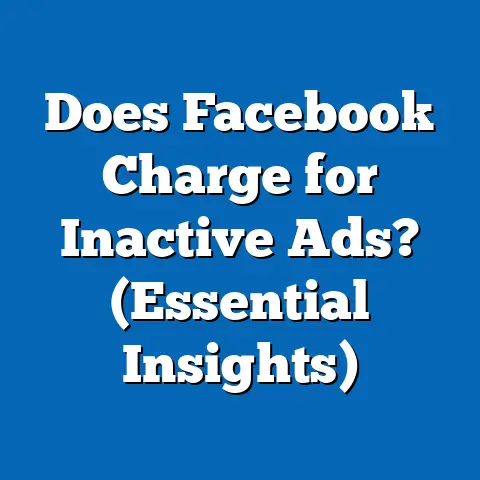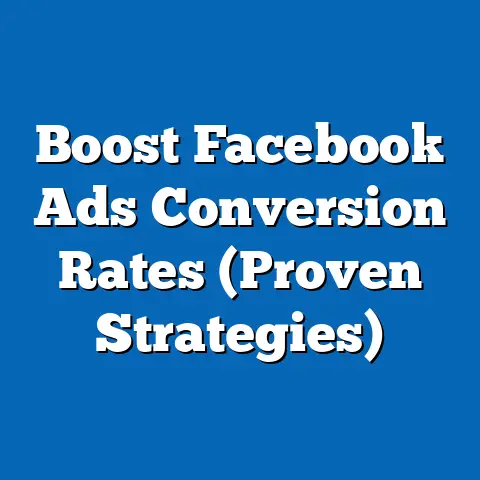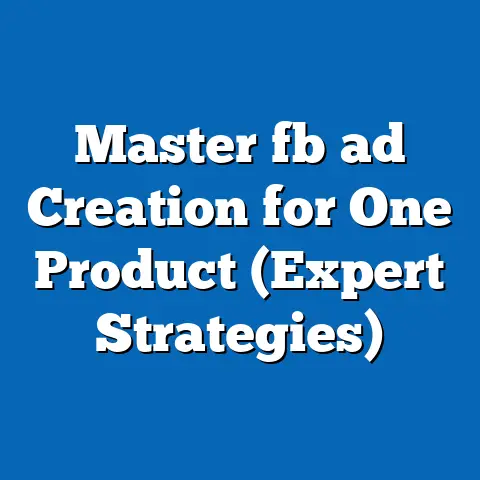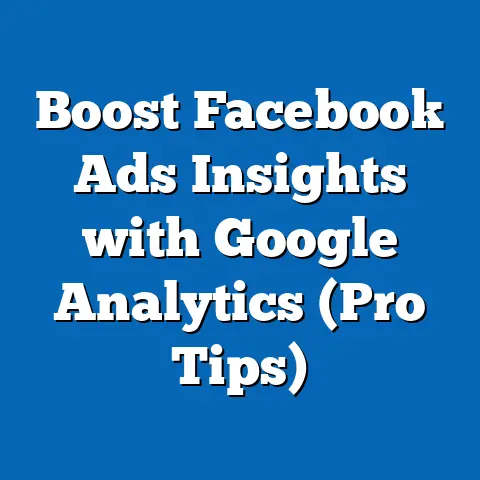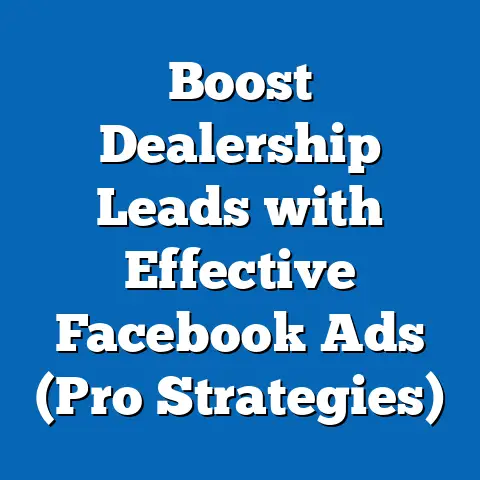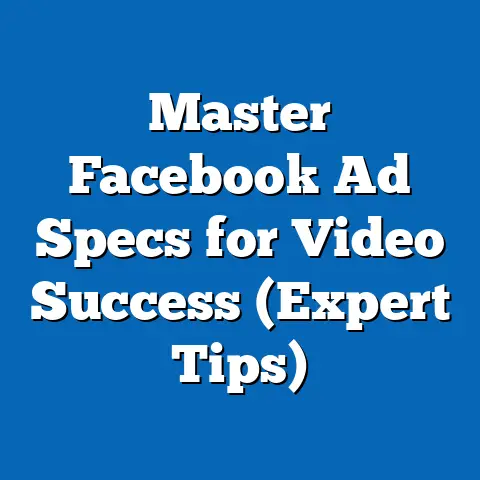Boost Google Ads on Facebook (Effective Optimization Tips)
I’ve seen firsthand the power of a well-coordinated digital marketing strategy. Remember Sarah, the owner of a small online boutique? She was struggling to get her products seen, despite having a fantastic inventory. Her Google Ads were barely breaking even, and her Facebook page felt like shouting into a void. Then, we decided to strategically integrate her Google Ads with Facebook advertising. Within three months, her ROI skyrocketed by 300%! This success story isn’t just a fluke; it showcases the incredible potential of leveraging both platforms to maximize ad performance and reach. In this guide, I’ll walk you through how you can achieve similar results by effectively integrating your Google Ads and Facebook campaigns.
Understanding the Synergy Between Google Ads and Facebook
Google Ads and Facebook Ads are often seen as separate entities, but in reality, they can be powerful allies. Understanding their individual strengths and how they complement each other is the first step to a successful cross-platform strategy.
Core Objectives: Google Ads vs. Facebook Ads
-
Google Ads: Primarily focuses on intent-based marketing. People actively search for products or services, and your ads appear based on their keywords. This is perfect for capturing users who are already looking for what you offer. The objective here is often immediate conversion – a purchase, a sign-up, a phone call.
-
Facebook Ads: Excels in discovery-based marketing. You target users based on their demographics, interests, behaviors, and connections, even if they aren’t actively searching for your product. This is ideal for brand awareness, generating leads, and re-engaging potential customers. The objective can range from building brand awareness to driving traffic and generating leads.
Google Ads: Primarily focuses on intent-based marketing. People actively search for products or services, and your ads appear based on their keywords. This is perfect for capturing users who are already looking for what you offer. The objective here is often immediate conversion – a purchase, a sign-up, a phone call.
Facebook Ads: Excels in discovery-based marketing. You target users based on their demographics, interests, behaviors, and connections, even if they aren’t actively searching for your product. This is ideal for brand awareness, generating leads, and re-engaging potential customers. The objective can range from building brand awareness to driving traffic and generating leads.
The Power of Cross-Platform Marketing
Imagine a potential customer searching for “organic coffee beans” on Google and clicking on your ad. They browse your website but don’t make a purchase. Later, while scrolling through Facebook, they see a compelling ad showcasing your organic coffee beans, complete with customer testimonials and a special discount. This coordinated approach significantly increases the likelihood of a conversion.
Cross-platform marketing enhances visibility and engagement because it:
- Reinforces your message: Seeing your brand on multiple platforms increases brand recall and recognition.
- Targets different stages of the customer journey: Google Ads can capture initial interest, while Facebook Ads can nurture leads and drive conversions.
- Provides valuable data insights: By tracking performance across both platforms, you gain a comprehensive understanding of your customer’s behavior.
Industry Insights
According to a recent study by HubSpot, businesses that use integrated marketing campaigns see an average of 24% more revenue compared to those that rely on single-channel strategies. This highlights the tangible benefits of a unified approach.
Takeaway: Google Ads and Facebook Ads are powerful tools in their own right, but their true potential is unlocked when used together. By understanding their unique strengths and integrating your campaigns, you can significantly boost your marketing performance.
Setting Up Your Google Ads for Facebook Optimization
Optimizing your Google Ads to work in harmony with your Facebook campaigns requires a strategic approach. It’s not just about running ads on both platforms; it’s about creating a cohesive message and targeting the right audiences.
Creating a Google Ads Campaign for Facebook Audiences
The key here is to think about how your Google Ads can complement your Facebook ads. Consider these steps:
- Demographic Insights: Use Facebook’s demographic data (age, gender, location, education) to inform your Google Ads targeting. For example, if your Facebook ads are performing well with women aged 25-34 in urban areas, focus your Google Ads budget on similar demographics.
- Interest and Behavioral Targeting: Facebook allows you to target users based on their interests and behaviors. Use this data to identify relevant keywords for your Google Ads campaigns. For example, if you’re targeting users interested in “sustainable living” on Facebook, include keywords like “eco-friendly products,” “organic clothing,” and “zero-waste lifestyle” in your Google Ads.
- Custom Audiences: Create custom audiences in Google Ads based on your Facebook audience data. You can upload your Facebook customer list or use website retargeting to target users who have interacted with your Facebook ads.
Refining Ad Copy and Visuals
Your ad copy and visuals should be cohesive across both platforms. This doesn’t mean using the exact same ads, but rather ensuring a consistent brand message and visual style.
- Align Messaging: Your Google Ads ad copy should echo the themes and benefits highlighted in your Facebook ads. This creates a sense of familiarity and reinforces your brand message.
- Use Consistent Visuals: Use similar colors, fonts, and imagery in your Google Ads and Facebook ads. This helps maintain brand consistency and makes your ads more recognizable.
- Highlight Unique Selling Propositions (USPs): Clearly communicate your USPs in both your Google Ads and Facebook ads. What makes your product or service stand out from the competition?
Takeaway: Setting up your Google Ads for Facebook optimization involves strategic targeting, cohesive messaging, and consistent branding. By understanding your Facebook audience and tailoring your Google Ads accordingly, you can create a powerful synergy that drives results.
Budgeting and Bidding Strategies
Budgeting and bidding are critical components of any successful advertising campaign. When integrating Google Ads with Facebook, it’s essential to allocate your budget effectively and choose bidding strategies that align with your goals.
Budgeting Techniques for Maximizing Ad Spend
- Set a Clear Budget: Determine your overall advertising budget and allocate a portion to both Google Ads and Facebook Ads.
- Track Performance: Monitor the performance of your campaigns on both platforms and adjust your budget accordingly. Allocate more budget to campaigns that are delivering the best results.
- Use a Test Budget: Before committing to a large budget, run a test campaign with a smaller budget to identify what works best.
- Consider Seasonal Trends: Adjust your budget based on seasonal trends and peaks in demand. For example, if you’re selling holiday gifts, increase your budget during the holiday season.
Aligning Bidding Strategies
- Google Ads Bidding Strategies: Google Ads offers various bidding strategies, including manual CPC, automated bidding (Target CPA, Target ROAS, Maximize Conversions), and smart bidding. Choose the bidding strategy that aligns with your goals.
- Manual CPC: Gives you control over your bids, but requires more monitoring and optimization.
- Automated Bidding: Uses Google’s machine learning to optimize your bids for conversions or ROAS.
- Facebook Bidding Strategies: Facebook also offers different bidding strategies, including cost per click (CPC), cost per impression (CPM), and cost per action (CPA).
- CPC: Pay for each click on your ad.
- CPM: Pay for every 1,000 impressions of your ad.
- CPA: Pay for each action taken on your ad (e.g., a purchase or sign-up).
- Aligning Strategies: If your goal is to drive conversions, consider using a CPA bidding strategy on both Google Ads and Facebook Ads. If your goal is to increase brand awareness, focus on CPM bidding on Facebook and broad keyword targeting on Google Ads.
- Manual CPC: Gives you control over your bids, but requires more monitoring and optimization.
- Automated Bidding: Uses Google’s machine learning to optimize your bids for conversions or ROAS.
- CPC: Pay for each click on your ad.
- CPM: Pay for every 1,000 impressions of your ad.
- CPA: Pay for each action taken on your ad (e.g., a purchase or sign-up).
Effective Budget Allocation
Here’s an example of effective budget allocation between Google Ads and Facebook:
- Scenario: You have a monthly advertising budget of $5,000.
- Allocation:
- Google Ads: $3,000 (60%) – Focus on capturing high-intent users searching for your products or services.
- Facebook Ads: $2,000 (40%) – Focus on building brand awareness, generating leads, and retargeting website visitors.
- Google Ads: $3,000 (60%) – Focus on capturing high-intent users searching for your products or services.
- Facebook Ads: $2,000 (40%) – Focus on building brand awareness, generating leads, and retargeting website visitors.
Takeaway: Effective budgeting and bidding strategies are essential for maximizing your ad spend. By setting clear budgets, tracking performance, and aligning your bidding strategies across both platforms, you can achieve optimal outcomes.
Crafting Engaging Ad Content
Engaging ad content is the cornerstone of any successful advertising campaign. Whether it’s a text ad on Google or a visual ad on Facebook, your content needs to capture attention, convey your message effectively, and drive action.
Elements of High-Converting Ad Content
- Compelling Headline: Your headline is the first thing people see, so it needs to be attention-grabbing and relevant.
- Clear and Concise Copy: Use clear, concise language that communicates the benefits of your product or service.
- Strong Call to Action (CTA): Tell people what you want them to do (e.g., “Shop Now,” “Learn More,” “Sign Up”).
- High-Quality Visuals: Use high-quality images or videos that are visually appealing and relevant to your message.
- Social Proof: Include social proof elements like customer testimonials, reviews, or ratings to build trust and credibility.
The Significance of A/B Testing
A/B testing involves creating multiple versions of your ad and testing them against each other to see which performs best. This is crucial for optimizing your ad content and improving your results.
- Test Headlines: Try different headlines to see which generates the most clicks or conversions.
- Test Ad Copy: Experiment with different ad copy to see which resonates best with your target audience.
- Test Visuals: Test different images or videos to see which is most visually appealing and effective.
- Test CTAs: Try different CTAs to see which drives the most action.
Creating Cohesive Messaging
- Consistent Brand Voice: Maintain a consistent brand voice across both platforms. Your ads should sound like they’re coming from the same brand.
- Align with Brand Identity: Ensure your ad content aligns with your brand identity and values.
- Appeal to Target Audiences: Tailor your ad content to appeal to the specific interests and needs of your target audiences on each platform.
Takeaway: Crafting engaging ad content involves creating compelling headlines, clear copy, strong CTAs, high-quality visuals, and social proof elements. A/B testing and cohesive messaging are essential for optimizing your ad content and driving results.
Utilizing Retargeting and Remarketing
Retargeting and remarketing are powerful strategies for re-engaging potential customers who have previously interacted with your brand. By targeting users who have visited your website, viewed your products, or engaged with your content, you can significantly increase your chances of conversion.
Understanding Retargeting and Remarketing
- Retargeting: Involves showing ads to users who have visited your website or interacted with your content. The goal is to bring them back to your site and encourage them to take action.
- Remarketing: A broader term that encompasses retargeting and other strategies for re-engaging potential customers. This can include email marketing, social media advertising, and other forms of outreach.
Setting Up Retargeting Campaigns
- Install Tracking Pixels: Install the Google Ads tracking pixel and the Facebook pixel on your website. These pixels track user behavior and allow you to create retargeting audiences.
- Create Retargeting Audiences: In Google Ads and Facebook Ads, create retargeting audiences based on specific user actions. For example, you can create an audience of users who have visited your product pages but haven’t made a purchase.
- Craft Targeted Ads: Create targeted ads that address the specific needs and interests of your retargeting audiences. For example, if a user has viewed a specific product, show them an ad featuring that product with a special discount.
- Set Up Retargeting Campaigns: Create retargeting campaigns in Google Ads and Facebook Ads and target your retargeting audiences with your targeted ads.
Using Audience Insights to Improve Targeting
- Analyze Facebook Audience Insights: Use Facebook Audience Insights to gain a deeper understanding of your retargeting audiences. What are their interests, demographics, and behaviors?
- Refine Google Ads Targeting: Use the insights from Facebook Audience Insights to refine your Google Ads targeting. For example, if you discover that your retargeting audience is interested in a specific topic, add that topic as a keyword in your Google Ads campaign.
- Create Lookalike Audiences: Use Facebook to create lookalike audiences based on your retargeting audiences. These are audiences that share similar characteristics with your existing customers, making them more likely to convert.
Takeaway: Retargeting and remarketing are essential strategies for re-engaging potential customers and driving conversions. By setting up retargeting campaigns and using audience insights to improve targeting, you can significantly boost your advertising performance.
Analyzing Performance Metrics
Analyzing performance metrics is crucial for understanding the effectiveness of your advertising campaigns and making informed optimization decisions. By tracking key performance indicators (KPIs) on both Google Ads and Facebook Ads, you can identify what’s working, what’s not, and where to focus your efforts.
Case Studies of Successful Campaigns
Let’s dive into some real-world examples of businesses that have successfully integrated Google Ads and Facebook advertising.
Case Study 1: E-commerce Fashion Brand
- Challenge: Low brand awareness and stagnant sales.
- Strategy:
- Google Ads: Targeted keywords related to specific clothing items and fashion trends.
- Facebook Ads: Created visually appealing ads showcasing their latest collections, targeting users interested in fashion and style.
- Retargeting: Retargeted website visitors with ads featuring the products they viewed.
- Results:
- 30% increase in website traffic.
- 20% increase in sales.
- Improved brand awareness and customer engagement.
- Google Ads: Targeted keywords related to specific clothing items and fashion trends.
- Facebook Ads: Created visually appealing ads showcasing their latest collections, targeting users interested in fashion and style.
- Retargeting: Retargeted website visitors with ads featuring the products they viewed.
- 30% increase in website traffic.
- 20% increase in sales.
- Improved brand awareness and customer engagement.
Case Study 2: Local Restaurant
- Challenge: Difficulty attracting new customers and competing with larger chains.
- Strategy:
- Google Ads: Targeted local keywords related to food and dining.
- Facebook Ads: Created ads showcasing their menu items, special offers, and customer reviews, targeting users in the local area.
- Event Promotion: Used Facebook Events to promote special events and attract new customers.
- Results:
- 40% increase in website traffic.
- 25% increase in reservations.
- Improved brand reputation and customer loyalty.
- Google Ads: Targeted local keywords related to food and dining.
- Facebook Ads: Created ads showcasing their menu items, special offers, and customer reviews, targeting users in the local area.
- Event Promotion: Used Facebook Events to promote special events and attract new customers.
- 40% increase in website traffic.
- 25% increase in reservations.
- Improved brand reputation and customer loyalty.
Case Study 3: Software Company
- Challenge: Generating leads and increasing sign-ups for their software product.
- Strategy:
- Google Ads: Targeted keywords related to software solutions and industry-specific terms.
- Facebook Ads: Created educational content and thought leadership pieces, targeting professionals in their industry.
- Lead Generation: Used Facebook lead ads to capture contact information from potential customers.
- Results:
- 50% increase in leads.
- 35% increase in sign-ups.
- Improved brand credibility and authority.
- Google Ads: Targeted keywords related to software solutions and industry-specific terms.
- Facebook Ads: Created educational content and thought leadership pieces, targeting professionals in their industry.
- Lead Generation: Used Facebook lead ads to capture contact information from potential customers.
- 50% increase in leads.
- 35% increase in sign-ups.
- Improved brand credibility and authority.
Takeaway: These case studies demonstrate the power of integrating Google Ads and Facebook advertising. By targeting the right audiences, creating engaging content, and using retargeting strategies, businesses can achieve significant results.
Conclusion
Integrating Google Ads with Facebook advertising is a powerful strategy for maximizing your marketing performance and achieving sustained success. By understanding the synergy between these platforms, setting up targeted campaigns, crafting engaging content, and analyzing performance metrics, you can unlock the full potential of your advertising efforts.
Remember, ongoing optimization, testing, and data analysis are essential for achieving long-term results. Stay informed about the latest trends and best practices in digital marketing, and don’t be afraid to experiment with different strategies to see what works best for your business.
Call to Action
Ready to boost your Google Ads through Facebook? Take the first step by implementing the strategies discussed in this article. Start by defining your target audience, setting up a test campaign, and tracking your results. Share your experiences or seek further guidance on effectively integrating your Google Ads with Facebook. Let’s work together to achieve your digital marketing goals!

